 |
 |
 |
 |
 |
 |
| |
 |
|
 |
 |
 |
  |
  |
 |
 |
 |
 |
|
|
 |
|
 |
 |
 |
OPERA |
 |
|
 |
|
 |
 |
 |
| |
 |
| 
 |
Kaap Skil - Museum van Jutters & Zeelui
Kaap Skil - Maritime and Beachcombers Museum |
|
 |
 |
 |
 |
PROGETTISTA |
 |
|
|
 |
|
 |
 |
 |
| |
 |
|
 |
 |
 |
 |
DESCRIZIONE |
 |
|
|
 |
|
 |
 |
 |
| Tourist attraction |
 |
|
 |
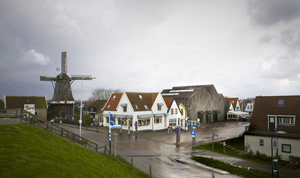 The island of Texel is situated in the Waddenzee and is the largest of the Dutch Wadden Islands. Every year a million or so tourists visit the island, which is only accessible by plane, boat or ferry. Few however will be familiar with the glorious history of Texel and its links with the Dutch East India Company. In the seventeenth and eighteenth centuries the Company’s fleet used the anchorage of Texel as its departure point for expeditions to the Far East. The ships waited there for a favourable wind before weighing anchor and sailing off to the ‘Orient’. While they waited, maintenance work and small repairs were carried out, victuals and water were brought on board and family could see their loved ones one last time. Many painters visited the ‘Reede van Texel’ (the offshore anchorage of Texel) to depict on canvas the fleet of the Dutch Republic. In the new entrance building of the maritime and beachcombers museum, Kaap Skil, in the hamlet of Oudeschild, the public is taken back in time to the Dutch Golden Age. The showpiece of the museum is an eighteen-metre long, four-metre deep model of the Reede van Texel, displaying in great detail the impressive spectacle of the dozens of ships anchored off the coast of the Wadden Island. The island of Texel is situated in the Waddenzee and is the largest of the Dutch Wadden Islands. Every year a million or so tourists visit the island, which is only accessible by plane, boat or ferry. Few however will be familiar with the glorious history of Texel and its links with the Dutch East India Company. In the seventeenth and eighteenth centuries the Company’s fleet used the anchorage of Texel as its departure point for expeditions to the Far East. The ships waited there for a favourable wind before weighing anchor and sailing off to the ‘Orient’. While they waited, maintenance work and small repairs were carried out, victuals and water were brought on board and family could see their loved ones one last time. Many painters visited the ‘Reede van Texel’ (the offshore anchorage of Texel) to depict on canvas the fleet of the Dutch Republic. In the new entrance building of the maritime and beachcombers museum, Kaap Skil, in the hamlet of Oudeschild, the public is taken back in time to the Dutch Golden Age. The showpiece of the museum is an eighteen-metre long, four-metre deep model of the Reede van Texel, displaying in great detail the impressive spectacle of the dozens of ships anchored off the coast of the Wadden Island. |
|
 |
 |
 |
|
 |
|
| Typical gable roofs |
 |
|
 |
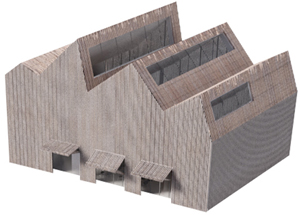 The museum is designed with four playfully linked gabled roofs which are a play on the rhythm of the surrounding roof tops which, seen from the sea, resemble waves rising out above the dyke. The museum is designed with four playfully linked gabled roofs which are a play on the rhythm of the surrounding roof tops which, seen from the sea, resemble waves rising out above the dyke.
‘The sea takes away and the sea provides’ – this is a saying that the people of Texel know so well. For hundreds of years they have made grateful use of driftwood from stranded ships or wrecks to build their houses and barns. The wooden façade of Kaap Skil is a good example of this time-hallowed tradition of recycling. The vertical wooden boards are made of sawn hardwood sheet-piling from the North Holland Canal and have been given a new life just like the objects in the museum collection. From within, the glass facade in front of the wooden boards allows an inviting view of the outdoor museum terrain and of the famous North Holland skies to visitors of the museum café. Inside the building the boards cast a linear pattern of daylight and shadow creating an atmosphere infused with light and shelter. |
|
 |
 |
 |
|
 |
|
| Daylight and artificial light |
 |
|
 |
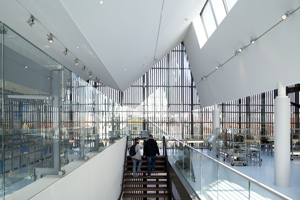 The entrance and the museum café form a natural frontier between the world of the Reede van Texel in the basement and that of the underwater archaeology on the first floor. The contrast between the two worlds is reinforced by the different experiences of light and space. In the basement visitors are drawn around the exhibition by projections and animations, creating an intimate space that harbours a sense of mystery. On the first floor the North Holland sky floods the objects on display with light. The movable showcases of robust steel frames and glass create a transparent effect so that the objects in the collection seem to float within the space. Under the high gabled roofs the visitor gets a generous sense of being able to survey the sizable collection, the museum grounds and the village of Oudeschild at a glance. The entrance and the museum café form a natural frontier between the world of the Reede van Texel in the basement and that of the underwater archaeology on the first floor. The contrast between the two worlds is reinforced by the different experiences of light and space. In the basement visitors are drawn around the exhibition by projections and animations, creating an intimate space that harbours a sense of mystery. On the first floor the North Holland sky floods the objects on display with light. The movable showcases of robust steel frames and glass create a transparent effect so that the objects in the collection seem to float within the space. Under the high gabled roofs the visitor gets a generous sense of being able to survey the sizable collection, the museum grounds and the village of Oudeschild at a glance. |
|
 |
 |
 |
 |
 |
 |
 |
VIDEO |
 |
|
|
 |
|
 |
 |
 |
| |
 |
|
 |
 |
 |
 |
MATERIALI |
 |
|
|
 |
|
 |
 |
 |
 |
 |
|
legno 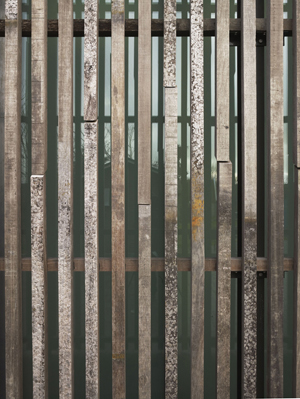 Mecanoo architecten searched for a facade material for Kaap Skil that would be sustainable in the broadest sense: aesthetic quality, longevity and environmentally friendly. The wooden slats used in the facades come from tropical hardwood wood piling from the North Holland Canal. A Mecanoo employee came across the wood after he had contacted the North Holland CO2 hotline about used building wood. He was sent to a contractor in the north of the Provence of Noord-Holland (close to Texel), who was commissioned by the department of Public Works to replace the 25 year old wood piling from the North Holland Canal. The wood piles were transported to Texel and cut into slats by the local sawyer Pieter Dros, yielding 10 kilometers worth. Mecanoo architecten searched for a facade material for Kaap Skil that would be sustainable in the broadest sense: aesthetic quality, longevity and environmentally friendly. The wooden slats used in the facades come from tropical hardwood wood piling from the North Holland Canal. A Mecanoo employee came across the wood after he had contacted the North Holland CO2 hotline about used building wood. He was sent to a contractor in the north of the Provence of Noord-Holland (close to Texel), who was commissioned by the department of Public Works to replace the 25 year old wood piling from the North Holland Canal. The wood piles were transported to Texel and cut into slats by the local sawyer Pieter Dros, yielding 10 kilometers worth.
The un-sawed edges have been deliberately placed on the visible side of the façade. After forty years of residence under water the white, gray, rust red, purple, brown colours are beautifully weathered. The untreated Azobé wood is strong, and the curvatures are perfect for a maritime museum. The vertical wooden battens (50 x 50 mm) cover both the front, the rear side as well as the roof. The 70mm spacing creates transparency into the museum if you stand in front of it: you look through to the rear museum grounds. Outside a tight alternation of open and sheltered is created and from inside, a fascinating and beautiful play of daylight and shadows.
|
|
 |
 |
 |
 |
LOCALIZZAZIONE |
 |
|
|
 |
|
 |
 |
 |

|
 |

|
Continente |
|
 |
|
Nazione |
|
 |
|
Regione |
|
 |
|
Città |
|
 |
|
Frazione |
|
 |
|
Indirizzo |
|
 |
|
|
|
 |
|
Telefono |
|
 |
|
Sito web |
|
 |
|
 |
 |
 |
 |
MAPPA |
 |
|
|
 |
|
 |
 |
 |
| |
 |
|
 |
 |
 |
 |
|
TIPOLOGIA |
 |
|
|
 |
|
 |
 |
 |
Principale |
 |
|
 |
ARCHITETTURA | Musei ed edifici per esposizioni
Musei marittimi
Musei etnografici
| |
|
|
 |
|
Accessoria |
 |
|
 |
ARCHITETTURA | Edifici per uffici e studi professionali
Uffici
Edifici commerciali
Bar, caffetterie
| |
 |
 |
 |
 |
CRONOLOGIA |
 |
|
|
 |
|
 |
 |
 |
Progetto |
 |
|
 |
| 
 |
2007 - 2009
|
|
Realizzazione |
 |
|
 |
| 
 |
2010 - 2011 |
|
 |
 |
 |
 |
PREMI |
 |
|
|
 |
|
 |
 |
 |
| 2013 |
 |
|
 |
Architizer A+ Award
Museums category |
|
 |
 |
 |
|
 |
|
| 2012 |
 |
|
 |
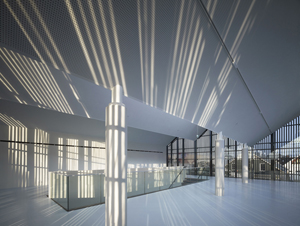 Daylight Award Daylight Award
Living Daylights Foundation
The jury commented on the awarding:
"Sun, clouds, thunder and rain: outdoors comes inside as perception and emotion and this is a core quality for a building with the Wadden Sea at your doorstep." |
|
 |
 |
 |
 |
 |
 |
 |
RIFERIMENTI BIBLIOGRAFICI |
 |
|
|
 |
|
 |
 |
 |
|
 |
| "Kaap Skil, Maritime and Beachcombers Museum, Texel, Netherlands. Mecanoo", A+U. Architecture and Urbanisme 506, november 2012 [Architecture in post-crisis], pp. 52-57 |
|
|
| Fatema Ahmed, "Texel Maritime Museum. Mecanoo", Icon 110, august 2012, pp. 42-43 |
|
|
| Andrew Dawes, "Sea shanty. Mecanoo", Architectural Review 1382, april 2012, pp. 60-65 |
|
 |
 |
 |
 |
 |
 |
 |
COMMITTENTE |
 |
|
|
 |
|
 |
 |
 |
| |
 |
| Maritiem & Jutters Museum, Oudeschild |
|
 |
 |
 |
 |
DATI
DIMENSIONALI |
 |
|
|
 |
|
 |
 |
 |
| Superficie |
 |
|
 |
|
 |
 |
 |
 |
STAFF |
 |
|
|
 |
|
 |
 |
 |
Progetto  |
 |
|
|
 |
|
|
 |
|
Consulente museografico |
 |
| Kossmann.dejong, Amsterdam |
|
Gestione progetto |
 |
| ABC Management Groep, Assen |
|
Appaltatore |
 |
| Bouwcombinatie De Geus & Duin Bouwbedrijf, Broek op Langedijk |
|
Costruttore |
 |
| Pieters Bouwtechniek, Utrecht |
|
 |
 |
 |
 |
CREDITS |
 |
|
|
 |
|
 |
 |
 |
| |
 |
Text edited by Mecanoo architecten
Photos © Christian Richters and Mecanoo architecten
Drawings © Mecanoo architecten
Courtesy by Mecanoo architecten
|
|
 |
  |
 |
|
|